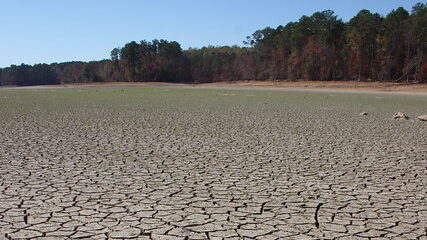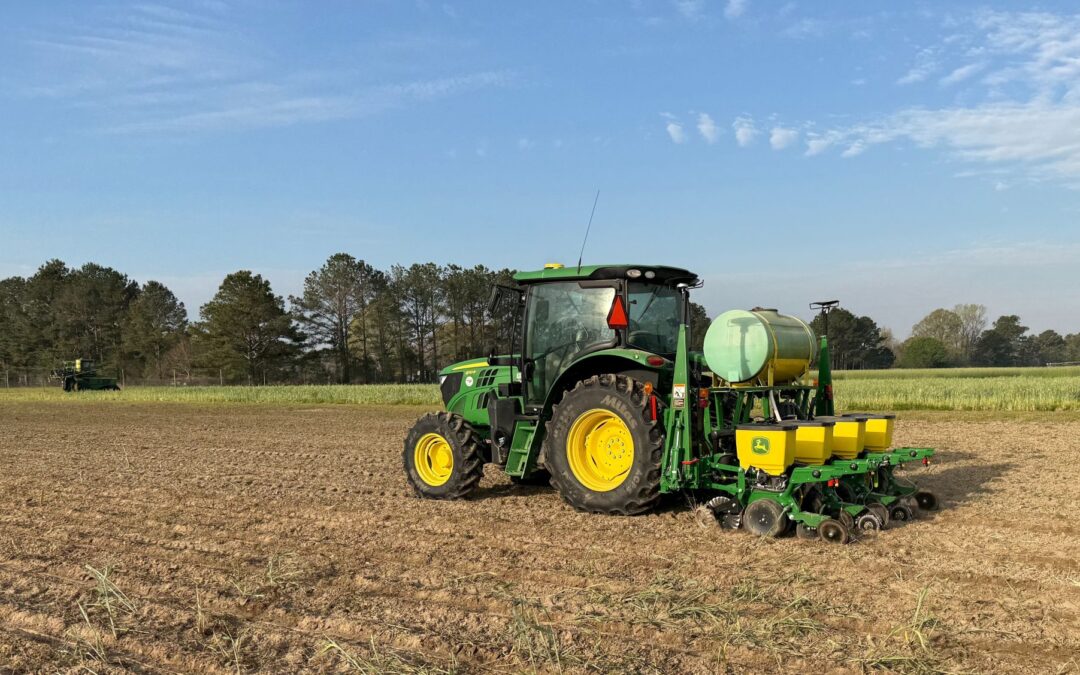Research shows Alabama barley good for beer, rotational crop
The first beer ever brewed from Alabama-grown barley made its debut this past fall, and Auburn University researchers are looking at even more possibilities for a crop that’s not so common to farmers in the Deep South.
Braided River Brewing Company in Mobile was one of the first breweries in the state to take advantage of incorporating an Alabama-grown barley into a beer. This was made possible thanks to a collaboration including researchers and experts from the Auburn College of Agriculture, the Alabama Agricultural Experiment Station (AAES), HudsonAlpha and Alabama A&M University.
“We brewed a fresh and floral pale ale this past fall named Harvest Ale,” said David Nelson, brewmaster at Braided River. “The malt tastes great and is the same quality as any other malt we’ve used, most of which is usually sourced from the Upper Midwest.”
The local barley malt already has attracted the interest of other Alabama breweries in Birmingham, Huntsville and Mobile, with a growing waiting list of potential buyers. The project resulting in the state’s first barley malt was funded by the Alabama Department of Economic and Community Affairs.
“We certainly like supporting our local economy,” Nelson said. “We also recognize that using in-state ingredients lessens our environmental impact, which is very important to our company.
“Harvest Ale is extra special, seasonal beer because it also incorporates Alabama-grown hops. The Cascade hops are experimental, too, as hops typically thrive in the Pacific Northwest. But these were grown a few miles from our brewery, at the (AAES) Ornamental Horticulture Research Center in Mobile.”
Researchers have shown that growing barley in Alabama is economically feasible, and that’s a critical first step, said Steve Hague, head of the Department of Crop, Soil, and Environmental Sciences in the Auburn College of Agriculture.
“If we cannot grow barley with a reasonable chance of success, then nothing else matters downstream,” Hague said. “In other parts of the U.S., barley is an excellent rotation crop that can add valuable organic matter to soil and improve overall soil health. Aside from the grain it produces, barley can be a useful winter forage crop.”
When the crop is in the soft dough stage and it appears, for whatever reason, to have a low grain yield potential, it is also possible for farmers to harvest the crop as a high-quality silage or hay for cattle, Hague explained.
“We need to take a harder look at barley’s potential in our forage programs in Alabama,” he said. “There is promise for this crop beyond just the brewing and distillation industries.”
Now that Auburn has demonstrated that the state’s farmers can provide consistent and affordable barley to spirit and beer artisans, the next level of this research project needs to examine the different flavor compounds produced by Alabama barley’s “terroir,” Hague said.
The French wine industry uses the term terroir to describe the influence that growing conditions have upon the quality of grapes, he said. Such factors include soil, temperature, moisture and soil microbial ecosystems.
This is why wines grown in different regions often have a distinct flavor and quality to them. The same can be said of the effect of barley’s terroir upon whiskey and beer.
Winners rise to the top in variety trials
The Official Variety Testing (OVT) program at Auburn put the first barley variety trials together in the fall of 2020, said Henry Jordan, variety testing manager for the college’s Department of Crop, Soil & Environmental Sciences. Limited barley trials were conducted in previous years at AAES outlying units.
“We started with 53 unique varieties of barley, with 25 provided by North Dakota State University from its barley uniformity trials,” Jordan said. “Twenty-eight additional lines were collected by the OVT program.”
The first trials were harvested in June of 2021 (considered the 2021 harvest season), beginning with two AAES locations: the Tennessee Valley Research and Extension Center in Belle Mina (North Region) and the E.V. Smith Research Center in Tallassee (Central Region).
In both 2021 and 2022, the central Alabama trials were severely impacted by cold temperatures.
“One would think that it would be the other way around,” Jordan said. “But the issue was that the plants in central Alabama had swapped from vegetative growth to reproductive growth when the freezing temperatures arrived, and this severely impacted yield. The plants in north Alabama were subjected to even colder temperatures, but the plants had not yet reached reproductive growth. These plants went on to make very good yields.”
After two years of inadequate yields in central Alabama, researchers moved their focus to north Alabama only. For the 2024 season, they added a second north Alabama location at the Sand Mountain Research and Extension Center.
“For the 2023 and 2024 seasons, we planted the same set of varieties at the Brewton Agricultural Unit,” Jordan said. “This location was not harvested for yield in 2023 although it looked great. The trial location was for our pathology team to evaluate the crop for disease. This trial was intentionally not sprayed with a fungicide in hopes of getting good disease pressure. Researchers then took ratings to determine if there are any varietal differences when it comes to disease resistance.”
Jordan sees barley fitting easily into a soybean and wheat rotation in Alabama.
“Since a grower is most likely going to convert only a small portion of their wheat acres to barley, this would be a good fit,” he said. “Planting, in-season maintenance and harvesting barley is very similar to wheat.”
Barley planting and harvest times are the same as for wheat, Jordan said. In north Alabama for the past four seasons, barley has been planted in the first two weeks of November and harvested in June, at a planting rate of 1.2 million seed per acre. The crop probably is better suited for the north region of the state, he said.
“Seed size can vary quite drastically by variety for both wheat and barley. Therefore, it is important to make sure that you pay attention to the number of seed per pound and calibrate your planter accordingly.”
While Jordan doesn’t see barley as a high-maintenance crop, he also doesn’t see it as a crop that can be planted and ignored.
“A good integrated pest management strategy is always the best plan,” he said. “A pre-emergence/early post-emergence herbicide that can provide residual control is recommended to prevent weeds from becoming established. If a grower has high winter weed pressure, an in-season herbicide application may be necessary.”
Barley yellow dwarf virus (BYD) is a significant pest of barley, Jordan said. It is introduced by aphids when they feed on the plant in the fall. Once a plant is infected, there is nothing that can be done to stop it. The best method for reducing BYD is to scout for aphids in the fall and spring. Once they are found at high enough levels, they can be controlled with an insecticide application.
Fertility also is important in barley production, and a soil test prior to planting can determine pH and whether any nutrients are lacking. A late-season application of fungicide is not required but may be necessary depending on the grower’s field, season weather and other factors.
“Compared to wheat, we typically use lower rates of nitrogen on barley for a couple of reasons,” Jordan said. “First, too much nitrogen can cause lodging (plants fall over) which can increase harvest difficulty and potentially reduce quality. Second, too much nitrogen can cause protein content to be out of range which could result in a rejection from the malt house.”
But the first and most important factor of growing any crop is yield, Jordan said. “Once you have that under control, grain quality is critical. Malters will look at test weight, protein content, percent moisture, percent germination and DON or deoxynivalenol. If any of these are not within range, they most likely will reject the barley for malting and brewing.”
DON is a mycotoxin resulting from a fungal infection. The disease is often referred to as Fusarium head blight (FHB) or head scab. DON can be present up to a designated threshold. Once the threshold is reached, the barley will be rejected for human consumption, though it still may be suitable for animal feed.
A few malt houses within a reasonable distance of north Alabama are currently buying Alabama barley, Jordan said, and growers in the region are showing an interest in adding the crop to their operations.
“Since barley is used in beer, taste is a factor,” he said. “Some varieties provide a more desirable flavor than others. One variety we tested is consistently high yielding. However, the malters and brewers do not like the flavor. So if anyone wants to grow barley, it would be best to have a discussion with the malt house prior to making a variety selection to ensure that a desirable variety is used.”
Measuring the profitability, marketability of barley
Auburn also is playing a major role in evaluating the financial feasibility of growing barley in Alabama, said Wendiam Sawadgo, assistant professor and Alabama Extension economist in the Department of Agricultural Economics and Rural Sociology.
“Our goal is to understand whether barley could be a profitable crop in Alabama, as there were only 190 acres of barley harvested in the state according to the 2022 Census of Agriculture,” said Sawadgo, who is also a researcher with the AAES.
He is working with Sthefani Oliveira, a research assistant, to make enterprise budgets for barley production.
These enterprise budgets are being produced with data from field trials conducted at the AAES Tennessee Valley Research Center in Belle Mina and will be used to determine under which scenarios barley would be profitable in Alabama.
Sawadgo is going a step further in his market analysis and measuring consumer willingness to pay for locally sourced beer.
“We’re conducting a statewide survey to assess whether Alabama consumers would be willing to pay a price premium for beer produced with Alabama-grown barley malt,” he said. “In essence, are the breweries using the Alabama-grown barley malt going to benefit more than if they had used malt from another state?”
Since this is a novel product, results from this part of the study will help determine whether there is consumer demand to support a market for Alabama barley, Sawadgo said.
“This study also complements some of my other research with the Experimental Economics Laboratory that assesses whether a price premium exists for produce items that are grown in Alabama or that are branded as Sweet Grown Alabama.”
Working with Sawadgo on the second part of the study are Samir Huseynov, assistant professor and leader of the Experimental Economics Laboratory, and graduate student Pathmanathan Sivashankar.
Results from the Auburn University OVT are available online. Results are reported in two formats, a PDF report and on an interactive variety selection tool. A quick 2023 barley summary for the north region is also available.
Anyone who would like to be notified of events or when data becomes available, can sign up for updates. The variety selection tool can allow users to digest a large dataset (multiple locations and years) much easier. Users can customize the variety selection process by looking at images of plots, weather data, trial management, and comparing varieties. The variety selection tool is financially supported by checkoff dollars from each of the commodity groups, Auburn University and the Alabama Cooperative Extension System.
A barley field day is planned at the Tennessee Valley Research and Extension Center in Belle Mina on Tuesday, May 14.





